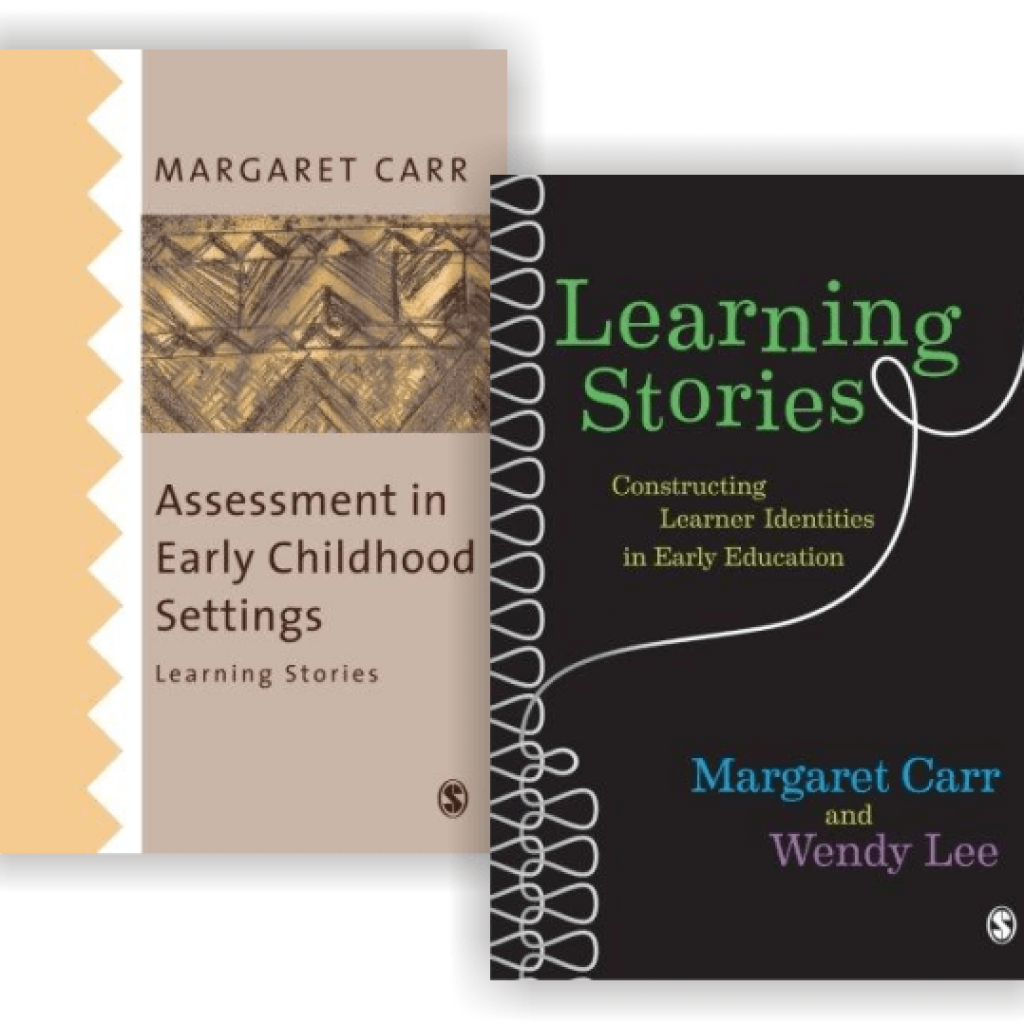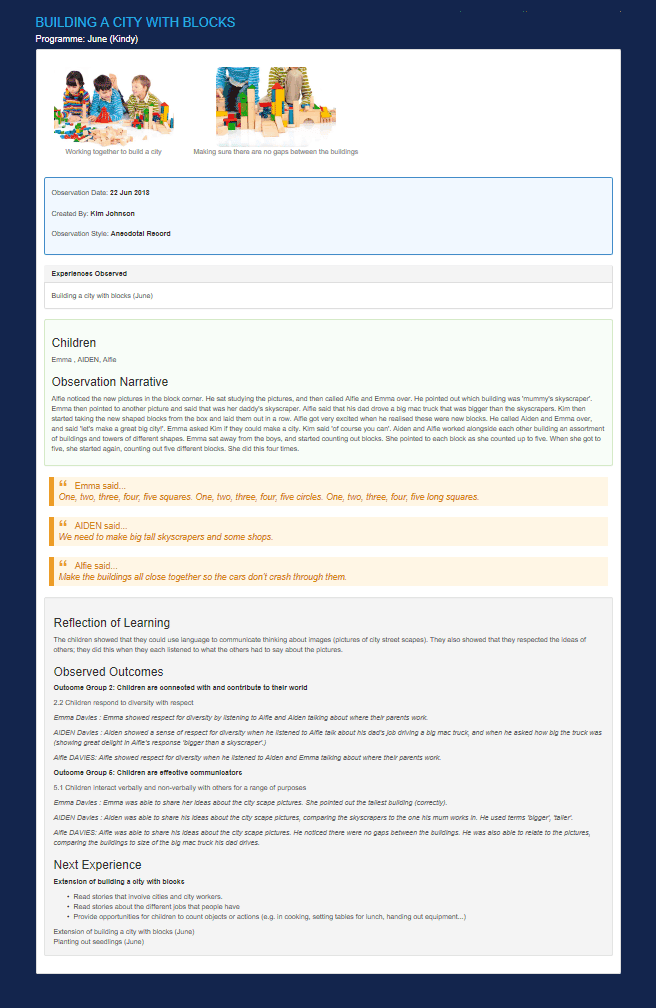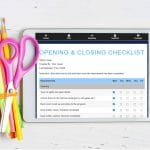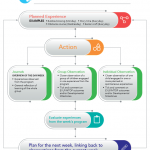Learning Story Observations
Learning stories are an observation type that tell a story about what an educator sees, hears, knows and interprets. They may include contributions from the child, the child’s family and other stakeholders.
Learning stories are an observation type that tell a story about what an educator sees, hears, knows and interprets. They may include contributions from the child, the child’s family and other stakeholders.
Learning stories were introduced by Margaret Carr in 2001 in her book “Assessment in Early Childhood Settings: Learning Stories” and further expanded upon in “Learning Stories: Constructing Learner Identities in Early Education” by Margaret Carr and Wendy Lee.
Learning stories are an important part of the programming and documentation planning cycle. For more information on the planning cycle, visit the EYLF Planning Cycle & EarlyWorks information page.

How to Write a Learning Story
 Unlike the clinical feel of anecdotal or running records, a learning story is a friendly and engaging insight to the child’s world. Most importantly, learning stories focus on strengths and abilities and provide subjective detail about a child initiated, unplanned sequence of events. Learning stories value the child as a competent and capable learner.Context also plays an important role in setting the scene of a learning story. Once the scene is set, the story captures the imagination of the reader.
Unlike the clinical feel of anecdotal or running records, a learning story is a friendly and engaging insight to the child’s world. Most importantly, learning stories focus on strengths and abilities and provide subjective detail about a child initiated, unplanned sequence of events. Learning stories value the child as a competent and capable learner.Context also plays an important role in setting the scene of a learning story. Once the scene is set, the story captures the imagination of the reader.
The educator becomes the “story teller”, telling the story from a first person perspective. Learning stories give the educator licence to add value by including their interpretation of the child’s thoughts, feelings and body language. This is different from more traditional forms of observation where the educator must try to remain objective.
EarlyWorks is a perfect tool for this style of documentation. Here are some guidelines as recommended by Tom Drummond:
- Title – All good stories have a title that draws the reader in. Educators record meaningful titles not only to draw the reader into the story, but also to assist in creating visible links between the observations and experiences recorded in EarlyWorks. Titles can act as a reminder of the content of the learning story, making it easy for educators to revisit at a later time.
- Photo – Learning stories should have at least one photo, or may include multiple images to show the story unfold. Images evoke emotion and a connection to the story. EarlyWorks allows Educators to add multiple images to any observations. Brief narratives that accompany images can enhance the story as the reader is taken on a visual journey through the events that unfolded.
- Narrative – This is where the story teller is describing what is seen, heard, known and believed from their own perspective. Written in the first person, using “I…”. The narrative is the body of the observation.
- What it means – This is where the storyteller reflects on the learning that took place and makes meaning of the dialogue that has occurred with the child. Writing is in the second person, using “You…”. In EarlyWorks, this is recorded as a Reflection of Learning.
- Opportunities and Possibilities – This is where educators record their planning. The focus is now on what could happen next to build on the learning that has just happened. In EarlyWorks, this is recorded as the Next Experience.
- Families & Child’s Voice – The child’s family is encouraged to provide their understanding of the story. Families may even create stories with their children, providing educators with valuable insight into the learning that happens at home.
Learning Stories are designed to be shared with the child and to capture the child’s responses to themselves as learners. Children may even suggest what should be included in the learning story.
EarlyWorks Learning Story Template
Within EarlyWorks, observations are recorded using a template. This template includes the Narrative, Reflection of Learning and Next Experience. In the example Colours, colours everywhere we can see how these are written as a Learning story.
The narrative is written in the first person and describes what the educator sees, hears and understands.
“I noticed Emma, Finn and Adam sitting together on the concrete. Emma seemed to be experimenting with a paint brush and a cup of water by painting onto the concrete. Emma was using the paintbrush to paint long strokes on the concrete. She watched as the water disappeared with the warmth of the sun. “Would you like some colour? I asked her in the hope of further extending this self-initiated experience. “Yea” she replied excitedly.”
The reflection of learning is also recorded and this is where an educator records “what it means” in dialogue with the children.
“Emma, Finn and Adam, you each created your own unique colours today. The most exciting things is that you all became scientists in the ways that you each continued to try new ways to make colours and to then change the colours you had made into something new. You learnt that adding more of a colour to the water turned the colour darker and that blue and yellow make the colour green. You shared what you were creating and learning along the way with your friends and each of you learnt more through listening to each other.”
Opportunities and possibilities are recorded as a pointer to next experience.
“Emma, Adam and Finn are enthusiastic about experimenting and intrigued by their ability to create and change something. We can explore the learning process of experimentation, trial and error, cause and effect more deeply with them by introducing a ‘Potion Station’ where they can experiment further with colours. This could be facilitated with clear beakers to best see the colour mixing, blotting paper to test out the colours and maybe a light table to enhance their vision of the end result. I would like to also encourage the children to photograph their own before and after results.”
Families can log into EarlyWorks and contribute their voice to the learning story. Families’ voices are gathered within the child’s portfolio. This valuable insight from families further informs the direction of the program. Educators can extend directly from family input and create a new experience.
In keeping with the learning story process, after the educator has shared the learning story with the child, the child’s voice is recorded in EarlyWorks. This is achieved by adding the child’s response to the story.
“Adam was really eager to hear his learning story. He asked if we could read it with his mum the very next morning. When we spoke about the mixing of colours he said, “see mum, I made Aqua – like your favourite. Adam’s mum said that he has been finding everything Aqua since yesterday and that she had told him that it was her favourite colour.”
Learning Stories can be viewed online or printed. EarlyWorks produces these as Microsoft Word documents. This allows educators to edit and redesign the layout as they wish. The observation and journal formats incorporate all strands of the learning story and provide educators with the ability to create links to the relevant learning framework and the National Quality Standards.



